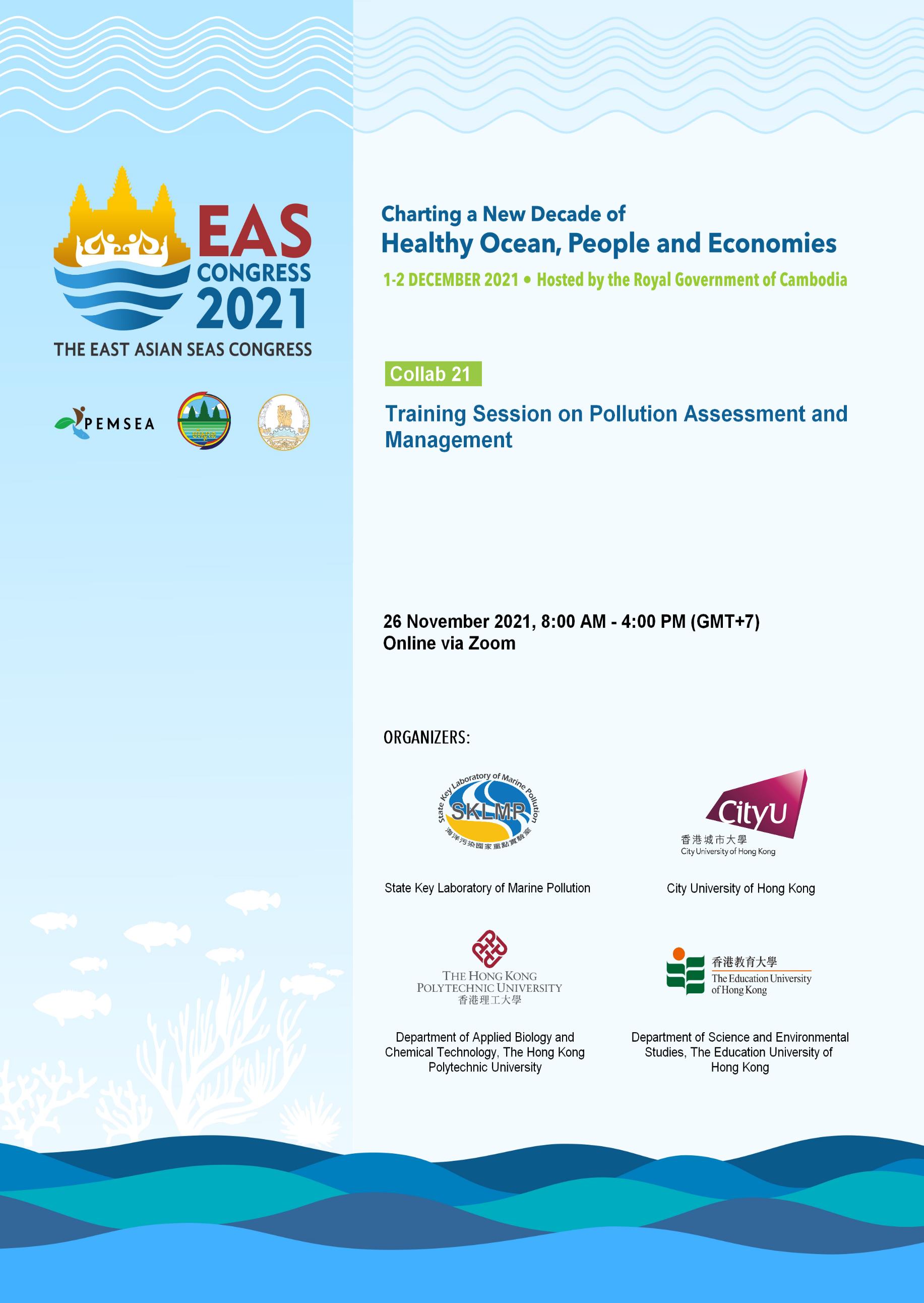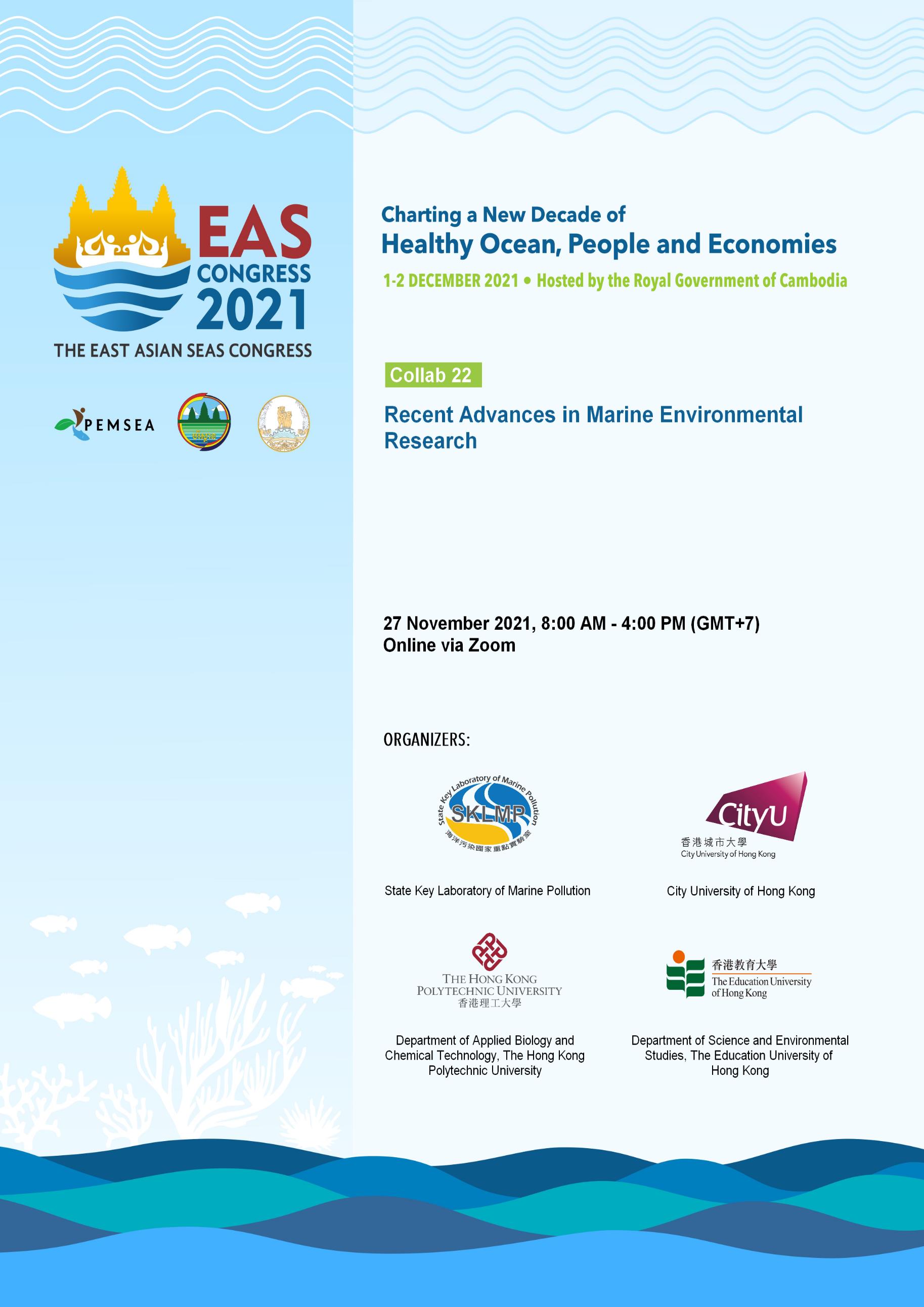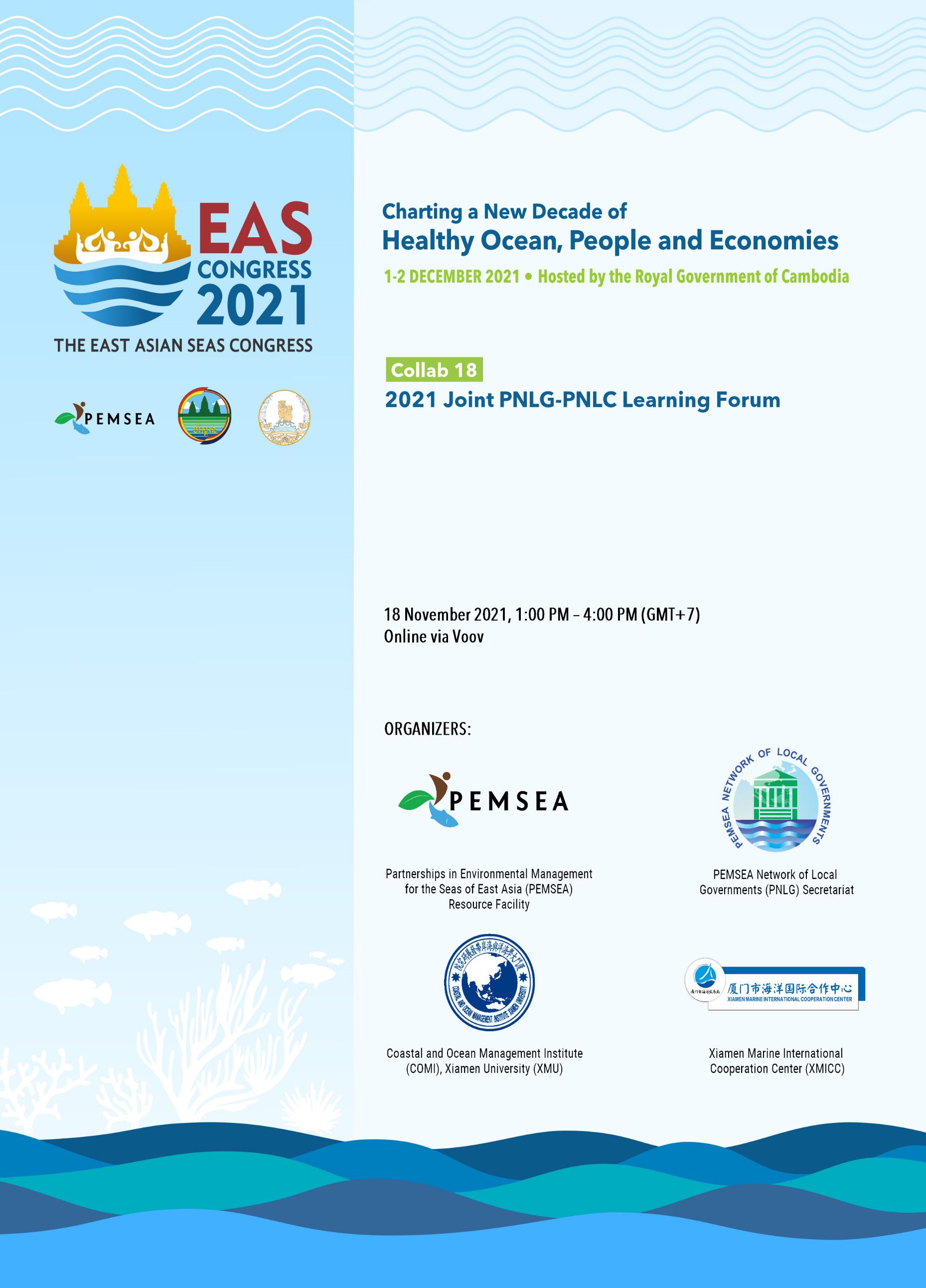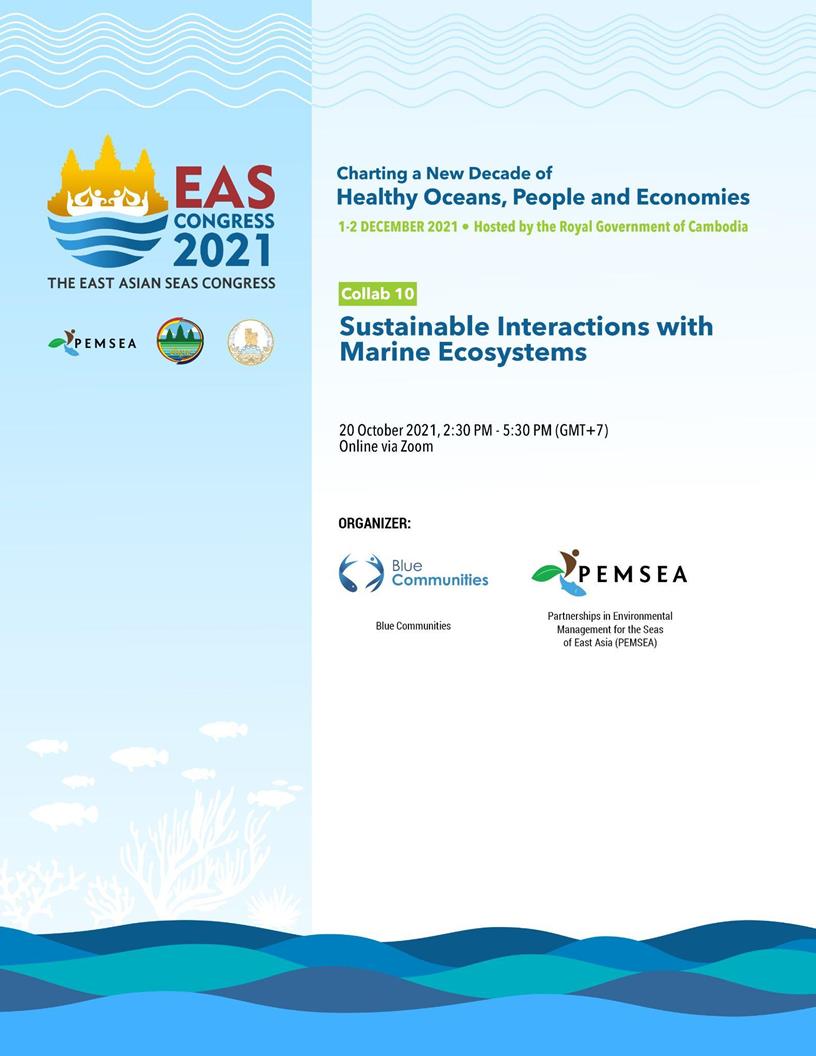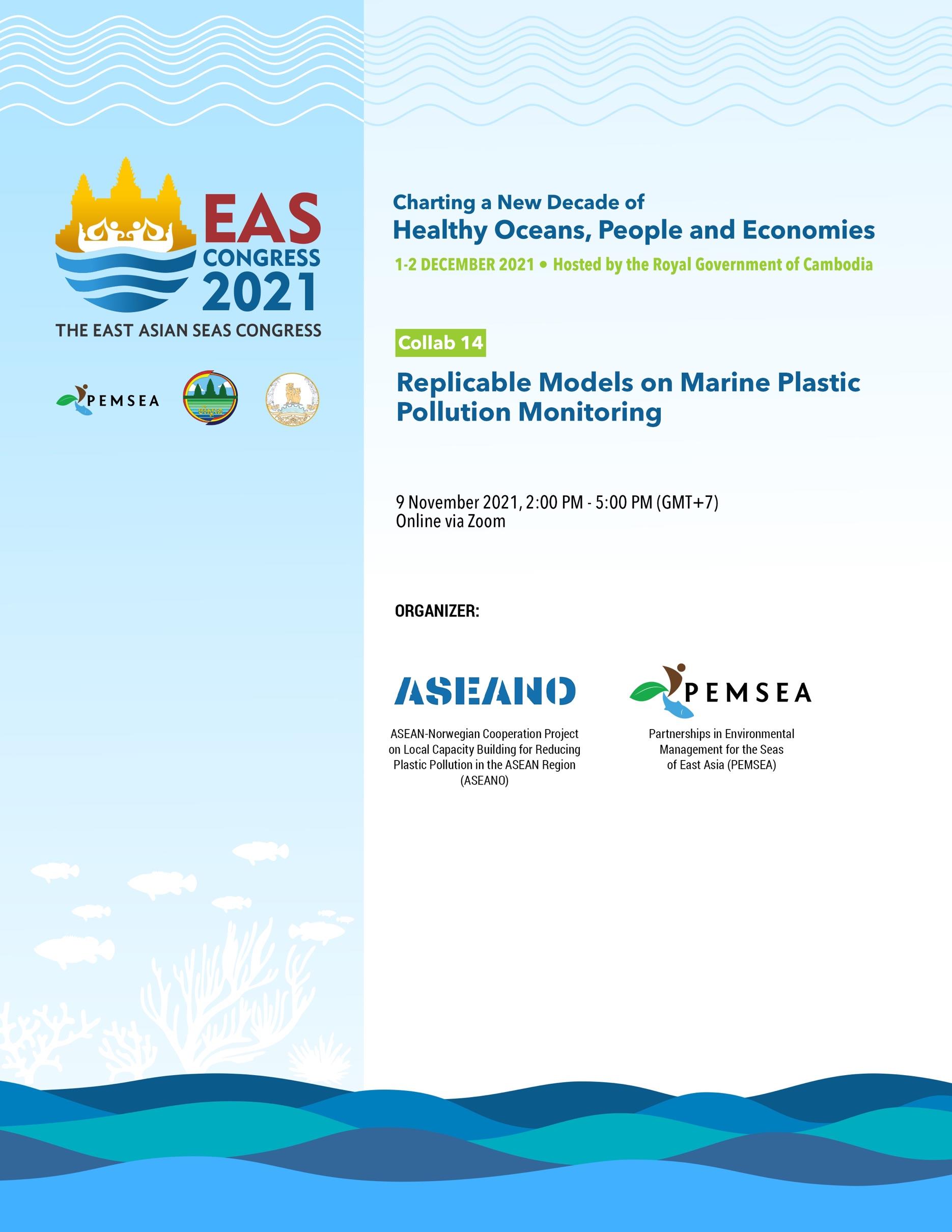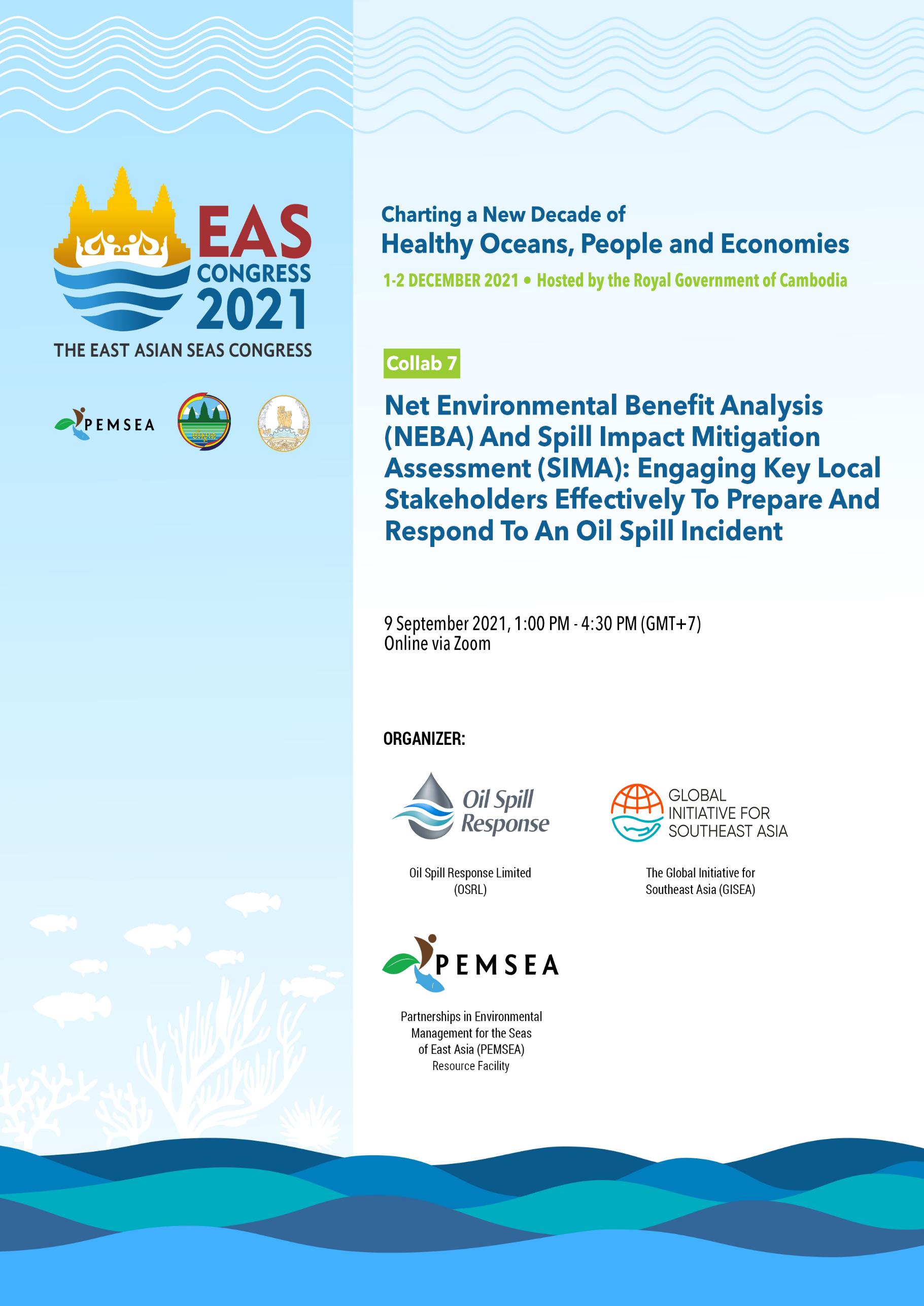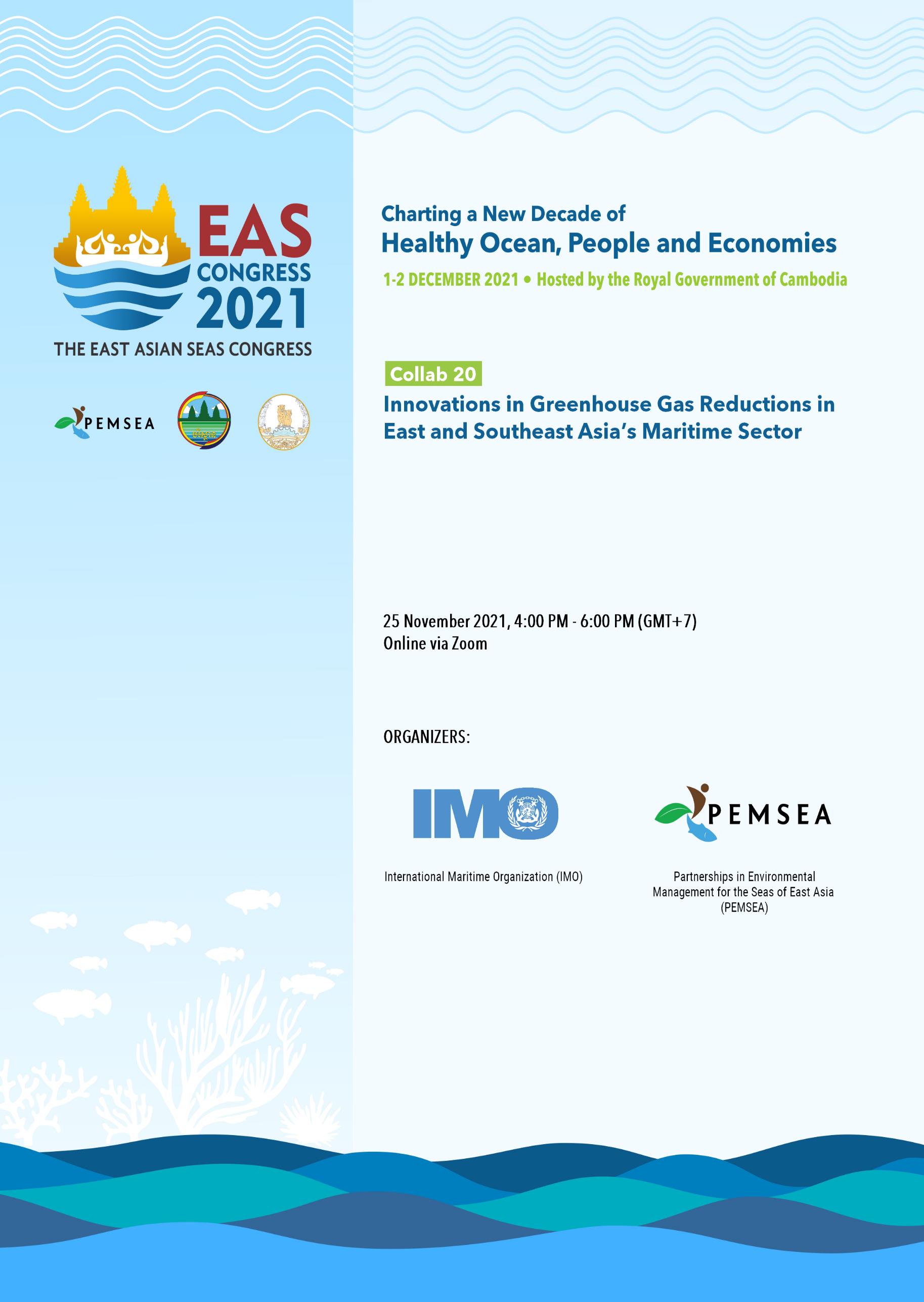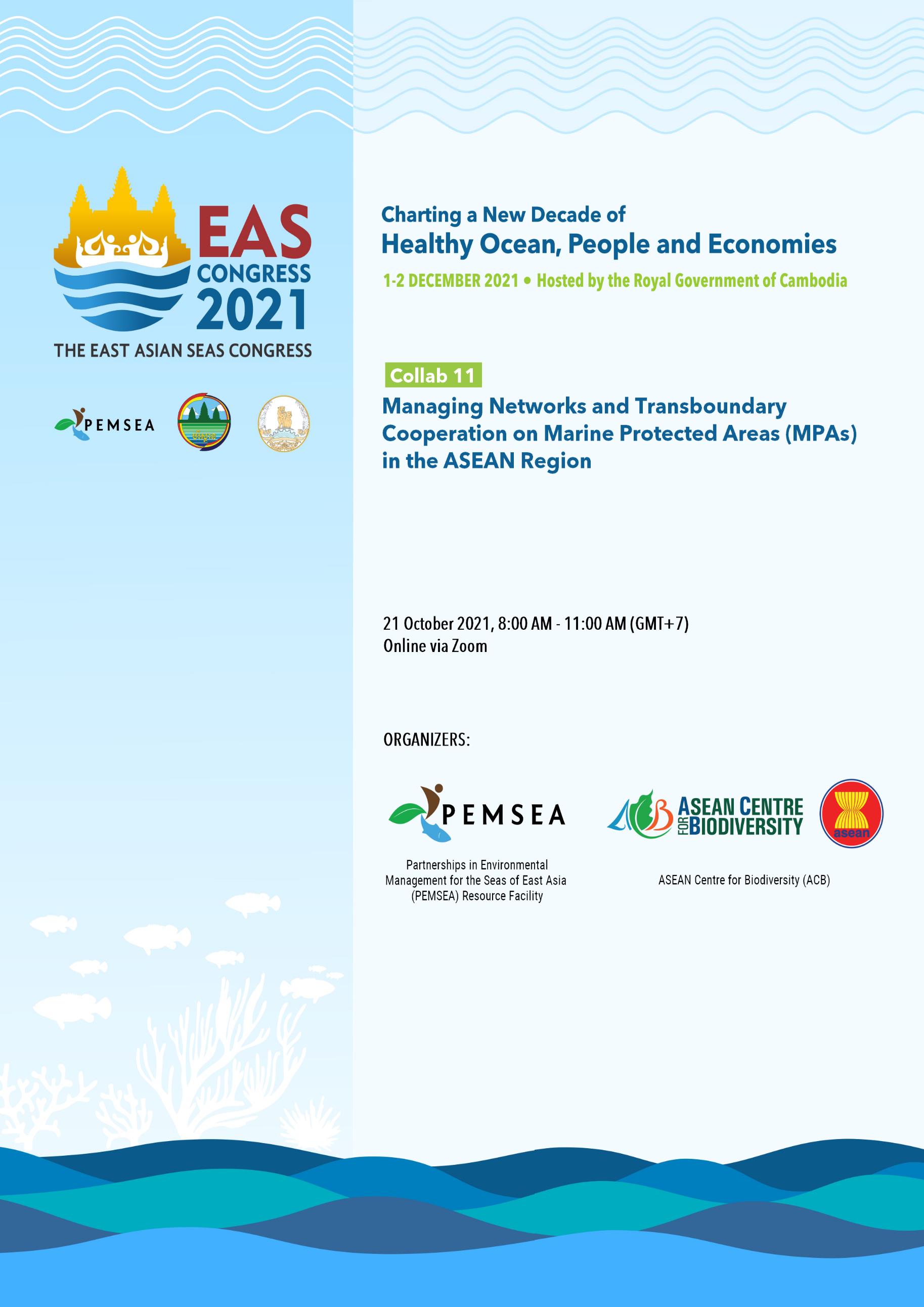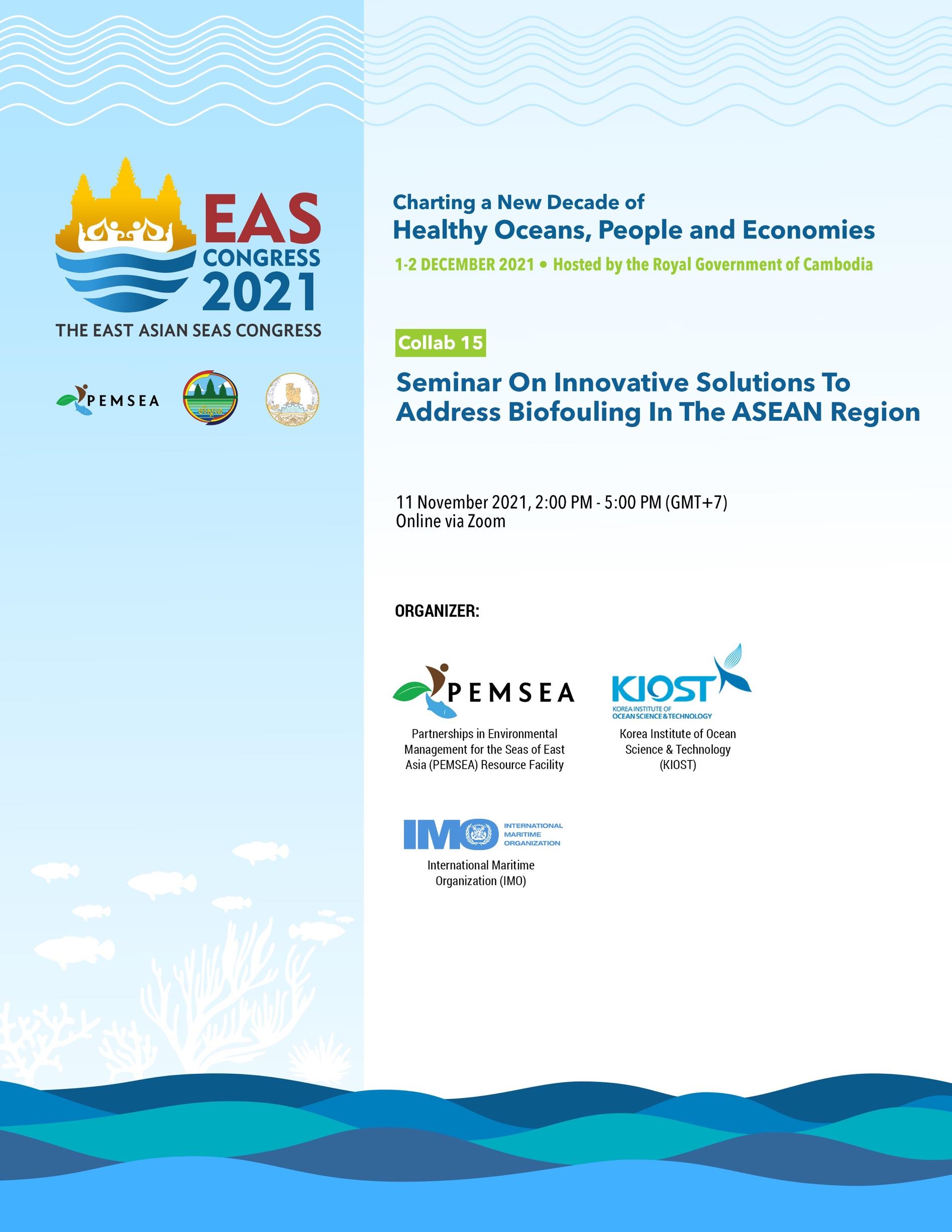
Breadcrumb
-
Collab 21: Training Session On Pollution Assessment And Management (PAM)
The training covered the concept, principles, and best practices in environmental risk assessment and management of chemical contaminants in water bodies from the standpoint of prospective, retrospective, and tiered approaches. The training also provided an overview of frontier technologies in monitoring and assessment of marine pollution.
-
Collab 22: Symposium On Recent Advances In Marine Environmental Research
With the goal of paving the way for capacity-building and research collaboration in Asia-Pacific, this symposium featured a series of talks on recent advances in pollution monitoring and control technologies, environmental risk assessment of emerging chemicals of concern, and ecological restoration through the eyes of leading experts from Hong Kong. Particular attention was given to toxins or man-made substances that pollute the ocean or affect its living biodiversity.
-
Collab 18: 2021 Joint PNLG-PNLC Learning Forum
Close to three decades of developing, implementing, and verifying the effectiveness of integrated coastal management (ICM) in terms of socioeconomic and environmental benefits have driven the replication and scaling up of ICM, covering more coastlines in the various countries in the East Asian Region. The replication and scaling up efforts were made possible with the issuance of necessary policies and supporting legislations by several countries in the region to support ICM implementation.
As scaling up efforts continue to accelerate in the coming decade, it is critical that the next generation of coastal managers and practitioners are adept in ICM principles, concept, framework, processes, and tools to enable them to effectively carry out their tasks and contribute to achieving local, national, regional, and global sustainable development targets in line with the United Nations Sustainable Development Goals. This event was also held under the World Ocean Week in Xiamen (XWOW) 2021.
-
Collab 10: Sustainable Interactions with Marine Ecosystems
The Collab Event organized by the GCRF Blue Communities programme office entitled “Sustainable Interactions with Marine Ecosystems” comprised 2 series of short presentations from project partners from Indonesia, Malaysia, Philippines and Vietnam, who presented their research and findings, each followed by panel sessions and then an opportunity for networking. The research highlighted the challenges faced by coastal communities in four case study sites, three of which are UNESCO Biosphere Reserves, and the fourth is a gazetted Marine Park.
The event brought together key actors from the Southeast Asia region interested in coastal communities and marine resources, academic researchers from Southeast Asia and the United Kingdom, as well as interested parties in marine management and policy. Representatives from each of GCRF Blue Communities 10 partner organizations and institutions were invited to present their work and participate in panel sessions sharing lessons learned from:
● Facilitating collaborative exchange among international partners to deliver and build capacity in interdisciplinary research
● Applying relevant research tools to address the challenges of coastal communities
● Disseminating the research findings to support coastal management decisions, and informing future efforts
This event provided a forum for the presentation and discussion of:
● The ecosystem services from natural capital in the Southeast Asia region
● Predicted changes in marine resources due to climate change, and how to prepare for the changes
● Trade-offs between conflicting demands on marine resources from different users
● Links between the marine coastal environment, ecosystems and human health
● Strategies for effective communication with, and engagement of stakeholders
-
Collab 14: Replicable Models on Marine Plastic Pollution Monitoring
The issue of marine plastic pollution has become internationally prominent in both public and policy circles. Eight million tons enter the ocean annually and consumption is expected to increase. East Asia is reported to produce over half of the plastic waste entering the oceans according to a 2015 report by Ocean Conservancy. Recognizing the region’s role in the plastic pollution crisis, the Association of Southeast Asian Nations (ASEAN) issued the Bangkok Declaration on Combating Marine Debris in June 2019 to signify the commitment of ASEAN countries to take concrete actions and collaborate on preventing and significantly reducing marine debris, including plastic waste. The PEMSEA Network of Local Governments (PNLG) has also issued a declaration towards combating the issue (https://dev-pemseaorg.pantheonsite.io/publications/agreements-and-publications/pemsea-network-local-governments-sustainable-coastal). These statements include the application of scientific knowledge to combat marine debris, such as by monitoring to support science-based policy and decision-making.
Much plastic waste in the ocean originates from land, and therefore a ‘source-to-sea approach’ is needed to handle marine plastic pollution. Additionally, monitoring guidelines and tools must be properly configured to the local context based on institutional capacity and socioeconomic and environmental circumstances. In this regard, collaboration between different countries and communities is crucial for sharing best practices and practical yet innovative solutions to understand how they might be replicated or scaled-up in new areas.
This collab highlighted the lessons learned from the ASEAN-Norwegian Cooperation Project on Local Capacity Building for Reducing Plastic Pollution in the ASEAN Region (ASEANO), and from other efforts in the region to reduce the flow of plastic waste into the ocean. Various projects shared examples of approaches to understanding and tackling the monitoring of plastic pollution issues, while providing peer-to-peer knowledge sharing between presenters and attendees.
-
Collab 7: Net Environmental Benefit Analysis (NEBA) and Spill Impact Mitigation Assessment (SIMA): Engaging Key Local Stakeholders Effectively to Prepare and Respond to an Oil Spill Incident
As the largest international industry-funded oil spill response organization, Oil Spill Response Limited (OSRL) plays a significant role in the promotion of the use of industry good practices to prepare for and respond to any oil spill incidents, through engaging various key stakeholders which may be involved in an incident.
OSRL collaborated with Partnerships in Environmental Management for the Seas of East Asia (PEMSEA) and Global Initiative – South-East Asia (GISEA) to deliver a virtual workshop on Net Environmental Benefit Analysis (NEBA) and Spill Impact Mitigation Assessment (SIMA) to support the Gulf of Thailand (GoT) Cooperation.
Purpose of the workshop is to introduce the concept of Net Environmental Benefit Analysis (NEBA) and Spill Impact Mitigation Assessment (SIMA) as an engagement tool to understand impacts of oil spill to the local community, compare the benefits of different response strategies and thereby reducing the overall impact to cultural, ecological, and socio-economic resources during an oil spill incident.
This workshop was held from 2:00 PM to 5:30 PM on 9th Sept 2021 and consists of presentations, worked examples walkthrough and scenario-based discussions. Please refer to Annexes A and B for the workshop programme and link to the presentations, respectively.
The workshop was attended by thirty-six participants from the littoral states of GoT sub-region, namely Cambodia, Thailand, and Vietnam. The delegation was headed by the national contact points and was also well-represented by a diverse group of stakeholders to provide an alternative perspective to the NEBA/SIMA discussion. Please refer Annex C for the full list of participants.
A team of five resources speakers and moderator were headed by OSRL and GISEA, with technical support from PEMSEA.
-
Collab 20: Innovations in Greenhouse Gas Reductions in East and Southeast Asia’s Maritime Sector
Over the last decade, maritime transportation has grown to almost 90 percent global oversea trading logistics and correspondingly produces 3%-5% of the total global GHG emission. Sixty percent of this total trade volume passes through the seas and ports of Asia.
According to the Fourth GHG Study of the International Maritime Organization (IMO), GHG emissions of total shipping have increased from 977 million tonnes in 2012 to 1,076 million tonnes in 2018 (9.6 percent increase) mostly due to a continuous increase of global maritime trade. The Study projects that shipping emissions could increase to 90-130 percent of 2008 emissions by 2050, pointing out that it will be difficult to achieve IMO’s 2050 GHG reduction ambition (i.e., reduce the total annual GHG emissions from shipping by at least 50 percent) through energy-saving technologies and approaches alone (e.g., slow steaming and Just in Time arrivals, among others). Under all projected scenarios, by 2050 a large share of the total amount of CO2 reduction will have to come from the use of low-carbon/zero-carbon alternative fuels.
A shift to low-carbon/zero-carbon fuels and energy sources is not solely a shipping issue, but one that cuts across the maritime transportation, fuel, and energy systems, requiring collaborative efforts to address all the subsystems in an integrated manner encompassing, among others, ships, ports, hinterland transport, cargo handling and logistics, low- carbon fuel sources and distribution, renewable energy supply, IT/communication and information-sharing, and so on.
-
Collab 11: Managing Networks and Transboundary Cooperation on Marine Protected Areas (MPAs) in the ASEAN Region
The ASEAN Centre for Biodiversity (ACB), in collaboration with the Partnerships in Environmental Management for the Seas of East Asia (PEMSEA), conducted a virtual session entitled Managing Networks and Transboundary Cooperation on Marine Protected Areas (MPAs) in the ASEAN Region as one of the pre-congress events of the East Asian Seas (EAS) Congress. The session was held on 21 October 2021 and hosted and moderated by Ms. Antoinette Taus, Founder and Executive Director of Communities Organized for Resource Allocation (CORA).
The virtual session aimed to discuss the status and progress of transboundary management of coastal and marine biodiversity in the ASEAN region. In particular, it sought to highlight the various initiatives and collaborative actions on sustaining healthy coastal and marine ecosystems through transboundary cooperation such as:
a. the concept of transboundary management in the context of Large MarineEcosystems (LMEs) to mitigate biodiversity loss and maintain productive coastal andmarine environment in the region;
b. the transboundary approaches at site, national, and regional levels in managingcoastal and marine habitats for migratory species;
c. lessons learned, good practices, and future plans related to strengthening capacitiesfor the conservation and sustainable management of MPAs;
d. effective management of MPAs through science-based approaches including keyemerging issues affecting coastal and marine environment in the ASEAN, such asclimate change and marine litter; and
e. communication, education, and public awareness (CEPA) strategies to advocate issuesdrivers of biodiversity loss.
The session also zoomed in on transboundary management in relation to the achievement of national, regional, and global commitments such as the post-2020 global biodiversity framework (GBF), UN Sustainable Development Goal (SDG) 14, and Sustainable Development Strategy of the Seas of East Asia (SDS-SEA) implementation. These commitments will contribute to the Congress’s goal in establishing a roadmap on transformative blue solutions for the next decade. Thus, the session presented an opportunity to forge new collaborations and partnerships among the ASEAN Member States (AMS) in protecting its coastal and marine environment, especially in improving the management of MPAs.
Participants of the session were composed of local, national, and regional representatives from AMS, academe, research institutions, non-governmental organisations, development partners from the ASEAN region and beyond. The programme appears as Annex 2 to this document, while Annex 3 contains the list of participants and Annex 4 the links to the recording and presentation materials.
-
Collab 15: Seminar on Innovative Solutions to Address Biofouling in the ASEAN Region
The introduction and establishment of Invasive Aquatic Species (IAS) is considered as one of the threats to the biodiversity of the world’s freshwater, coastal and marine ecosystems. The global economic impacts of IAS, including disruption to fisheries, damage to coastal industry and infrastructure, shipping industry, tourism industry and marine ecosystem services, have been estimated at several hundred million dollars per year (IMO). The main vectors of the unintentional transfer of non-indigenous species are ships' ballast water, biofouling of mobile marine structures and aquaculture practices.
Biofouling is the accumulation of aquatic microorganisms, plants, algae, or small animals on the surfaces and structures immersed or exposed to the aquatic environment. Significant research during the last 20 years have confirmed that biofouling had been underestimated as a possible vector for non-indigenous species and may in fact be one of the main mechanisms for their introduction or expansion of species into new marine or freshwater habitats.
Improving or minimizing biofouling on ships has the added benefit of improving their energy efficiency. As a result, biofouling has been identified as one of the potential key resources that may contribute in the short term to the reduction of greenhouse gas emissions from the shipping industry.
In order to improve the management of biofouling, minimize its role as a potential vector for the introduction of IAS and help maritime industries to reduce their carbon footprint, the International Maritime Organization (IMO), the United Nations Development Programme (UNDP) and the Global Environment Facility (GEF) have launched the GloFouling Partnerships Project. The project includes a conscious effort to seek the expertise accumulated by the private sector, through the Global Industry Alliance (GIA) for Marine Biosafety, a cross-sectoral platform that brings together global industries from maritime, shipping, ocean energy, aquaculture and other ocean-based industries to help identify common difficulties and solutions, facilitate technology development and break barriers for its uptake with the ultimate goal of improved biofouling management.
As a follow-up seminar to a Regional Seminar on Biofouling Management and Invasive Aquatic Species in the East Asian Seas which took place in 23 June 2021, this collab which is part of a series of collabs under the East Asian Seas Congress 2021 focused at sharing the latest technology and research initiatives and discussed how they may help maritime industries to address issues related to biofouling, in support of the implementation of the IMO Biofouling Guidelines at the regional and national levels in the ASEAN region.
